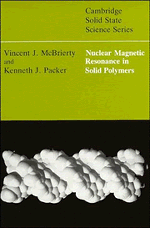Book contents
- Frontmatter
- Contents
- Preface
- Acknowledgements
- Glossary of terms
- 1 The NMR of solid polymers: an overview
- 2 Basic concepts in NMR
- 3 Nuclear spin interactions
- 4 Experimental methods
- 5 Structure and motion in solid polymers
- 6 Structural heterogeneity in polymers
- 7 Oriented polymers
- 8 Selected topics
- Appendix 1 Data on common polymers
- Appendix 2 The rotation operator
- Appendix 3 Rotation of tensors between coordinate frames
- Appendix 4 Spatial distribution of structural units in a polymer
- Appendix 5 The internal Hamiltonian
- Appendix 6 Spectral lineshapes
- Appendix 7 Analysis of spinning sidebands
- Bibliography
- References
- Author index
- Subject index
4 - Experimental methods
Published online by Cambridge University Press: 19 October 2009
- Frontmatter
- Contents
- Preface
- Acknowledgements
- Glossary of terms
- 1 The NMR of solid polymers: an overview
- 2 Basic concepts in NMR
- 3 Nuclear spin interactions
- 4 Experimental methods
- 5 Structure and motion in solid polymers
- 6 Structural heterogeneity in polymers
- 7 Oriented polymers
- 8 Selected topics
- Appendix 1 Data on common polymers
- Appendix 2 The rotation operator
- Appendix 3 Rotation of tensors between coordinate frames
- Appendix 4 Spatial distribution of structural units in a polymer
- Appendix 5 The internal Hamiltonian
- Appendix 6 Spectral lineshapes
- Appendix 7 Analysis of spinning sidebands
- Bibliography
- References
- Author index
- Subject index
Summary
The study of solid polymers by NMR requires spectrometers with rather special characteristics. In this chapter we outline their principal features and describe a number of experiments that explore different aspects of the way in which resonant nuclei behave: measurements on 1H, 2H and 13C predominate. The low natural abundance of 13C and the unusually broad deuterium linewidths pose special technical problems.
Although the emphasis throughout is on pulse methods of excitation, it is important to recall that, for the determination of spectra, the only method widely used for many years was the field or frequency sweep technique, often referred to as continuous wave (CW) excitation. In this method an rf field of small amplitude is applied continuously and either the B0 field or the rf frequency is swept across the resonance absorption. Because of the very different requirements of high-resolution measurements in liquids and the broad, low-resolution spectra characteristic of abundant spins in solids (for example 1H and 19F), quite different spectrometer designs evolved for these two areas. The so-called ‘broadline’ CW spectrometer used field modulation techniques which generate the derivative of the absorption lineshape. Corrections were often necessary to account for the fact that component lines of the spectrum with substantially different spin—lattice relaxation characteristics and linewidths responded differently to the imposed modulation.
- Type
- Chapter
- Information
- Nuclear Magnetic Resonance in Solid Polymers , pp. 82 - 123Publisher: Cambridge University PressPrint publication year: 1993



